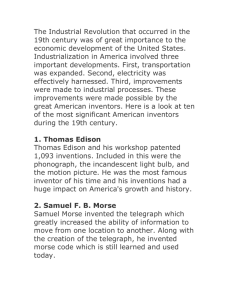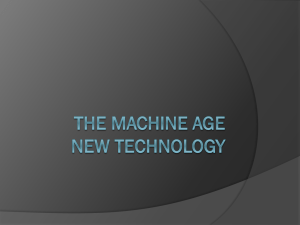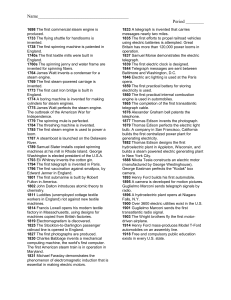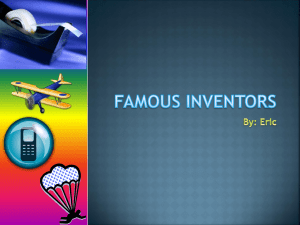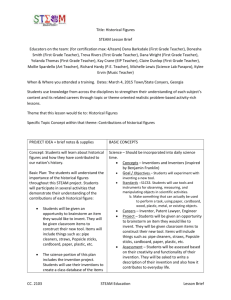5th Period - American Innovation and Inventiveness
advertisement
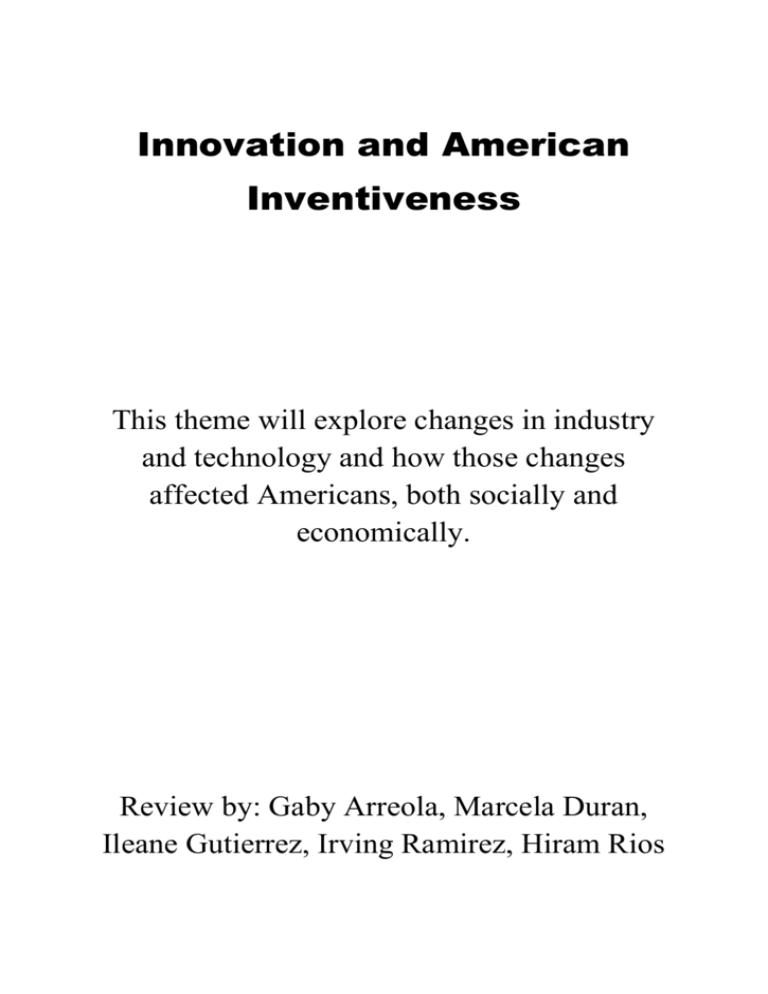
Innovation and American Inventiveness This theme will explore changes in industry and technology and how those changes affected Americans, both socially and economically. Review by: Gaby Arreola, Marcela Duran, Ileane Gutierrez, Irving Ramirez, Hiram Rios 1600s Innovation in the seventeenth century sparked many creations such as the first man powered submarine created by Cornelius Drebbel in 1620. The invention quickly altered the way oceanic warfare was fought allowing for stealth and strategic location. Another invention that helped alter the seventeenth century is the reflecting telescope created by Isaac Newton in 1668. Its creation helped change the simple subject of astronomy in a new dimension to be exploded. 1600s Key Terms Cornelius Drebbel- created the first man made submarine used for stealth and strategic location. SubmarineIsaac NewtonTelescope- 1700s In the 1700s some of the most important inventions came from one man Benjamin Franklin. He came up with the bifocals which helped give colonists a new outlook on life. Alone with the bifocals he invented the lightning rod helping to give a better understanding of electricity and how to harness it. In addition to his most famous inventions he was also the founder of the Franklin stove and the first fire department in the colonies. Similarly important is Eli Whitney's cotton gin that was patented in 1794 and revolutionized the way cotton was harvested doing up to 10x the work one slave could. Shorting the time it too took to take seeds out by more than half. 1700s Key Terms Benjamin FranklinBifocalsLightning Rod- 1800-1850 In the beginning of the 1800 American entered an era of technological innovation as it began to advance into an industrial nation. Starting with the man Eli Whitney he started the first to this era as he invented the concept of interchangeable parts. This led to the machine tool- industry which produced specialized machines for certain industries. The first industrial line was also introduced which not only increased the production but also made the production more uniform in quality. The textile industry also progress with the power loom which assisted in creating fabric at your own home. With the mass production that had developed transportation innovation was necessary. Transportation innovation also took its toll with the Erie Canal which was a passage of ship routes from the United States towards European countries. It was not only used for trade but to carry supplies. The invention of the steam engine also created the steam ship, a faster way of transportation and carrying more loads. As sea transportation became more efficient also ground transportation with the railroads in the 1830’s. This network connected multiple cities and changed the whole method of transporting goods. As travel time decreased also communicating with the first telegraph which allowed long distance communication. 1800-1850 Key Terms Technological innovation- advancement in technology Industrial- an era where the country went from an agricultural era to an industrial era with mass production Eli Whitney- a man that created the cotton gin along with the concept of interchangeable parts Interchangeable parts- the concept of creating parts of a machine that are removable in case one part is broken Machine tool- industry- industry that specialized in creating machines and tools for a certain industry Power loom- a machine that increased the speed of producing fabric, easy to carry and can work from your own home Erie Canal- ship routes that connected European countries to the United States Steam engine-an engine that is powered by steam Steam ship- a ship powered by the steam engine, increase in speed and power Railroads- tracks that connected multiple cities and can carry cargo Telegraph- device used to communicate through large distances 1851-1900 One of the most important inventions of the machine age was the light bulb, invented by Thomas A. Edison in 1876. Edison’s work soon developed the need of power plants. Many other advances such as these allowed for the extension of the workday and the wider availability of electricity. This period was often called the Age of Invention, where so many technological advancements where made. Subsequent generated opportunities for mass production, which then caused the economy to grow at a stupendous rate. In the years following many great inventors such as Isaac Singer who invented the sewing machine (1851), Georges Audemars invents rayon (1855); Hamilton Smith patents the rotary washing machine (1858) where all contributors to the 19th century the age of machine too, machines that made parts for other machines, including interchangeable parts. The assembly line was invented during the 19th century, speeding up the factory production of consumer goods. 1851-1900 Key Terms Light bulb- is widely used in household and commercial lighting, for portable lighting such as table lamps, car headlamps, and flashlights, and for decorative and advertising lighting. Thomas A. Edison- was an American inventor and businessman. He developed many devices that greatly influenced life around the world, including the phonograph, the motion picture camera, and a long-lasting, practical electric light bulb. Power plant- is an industrial facility for the generation of electric power. Age of Invention- the last quarter of the nineteenth century full of technological inventions Mass Production- is the production of large amounts of standardized products, including and especially on assembly lines. Isaac Singer- He made important improvements in the design of the sewing machine and was the founder of the Singer Sewing Machine Company. George Audemars- developed the first artificial silk now known as rayon. Hamilton Smith- invented the first rotary washing machine patented in 1858 1901-1950 The invention of the electric motor in the 1900's played a big role in the economic boom. Electric motors became essential for both work and home environments, used for industrial machines and house hold appliances. Due to this invention industries grew and offered more jobs. Due to Henry Ford perfecting the assembly line and mass production automobiles were now not only affordable to the wealthy. The automobile allowed people who worked in the cities to move farther away from city centers, which created the suburbs, the automobile was now an affordable necessity. Due to the impact of the automobile in the 1920's multiple areas were forced to develop roadways and means of policing traffic, by 1929 more than 23 million automobiles were registered in the united states. The radio as well as the automobile changed the nation’s culture, ten million families owned radios, and families would constantly get together and listen to the radio at home. Movies became tremendously popular during the decade, on movie screens one could see young, independent-minded, heroes and heroines defying all odds to succeed in romance and at the same time strike it rich. 1901-1950 Key Terms Electric motor - An electric machine than convert’s electrical energy into mechanical energy. Henry Ford- American industrialist, the founder of the Ford Motor Company, and sponsor of the development of the assembly line technique of mass production, Assembly Line - A series of workers and machines in a factory by which a succession of identical items is progressively assembled. Automobiles - A road vehicle, typically with four wheels, powered by an internal combustion engine or electric motor and able to carry a small number of people. Suburbs- An outlying district of a city, especially a residential one. Radio- The transmission and reception of electromagnetic waves of radio frequency, especially those carrying sound messages. Movies- A story or event recorded by a camera as a set of moving images and show in theater or on television; a motion picture. 1951- Present One huge government project that took place under President Eisenhower (19531961) was the Interstate Highway System. It was an extremely costly project that was made in part for it to be easier to transport soldiers and nuclear missiles throughout the country, but promoted tourism and the creation of suburbs. A large part of Americans began to live in suburbs beginning in that decade because of the system, and it is still very important in American culture. The Cold War was in effect during this time and because the U.S. did not want to fall behind the Soviet Union in technology, it created NASA or the National Aeronautics and Space Administration. The launching of Sputnik (1957) by the USSR was what led to the rapid creation and funding of the program, and math and science were also promoted more during the decade. Television made its great appearance in the 50s and has continued to be extremely popular. In the 1950s it promoted the era of consensus and consumerism by making people largely accept certain ideals. It played a role in the debates between John F. Kennedy and Richard Nixon, for example, and began to televise important events as well. Personal computers (PC) also made their appearance in the late 1960s and became more popular throughout the 70s although they were still too expensive for many people to own. They were about the size of a typewriter and limited in functions. In the 80s they began to be developed more for households, and have continued to be ever-present in American lives, especially in present day. 1951-Present Key Terms Interstate Highway System: developed under President Eisenhower, it is the national network of highways of the U.S. Its costly construction was authorized by the Federal Aid Highway Act of 1956. National Aeronautics and Space Administration (NASA): agency of the U.S. dedicated to space research and aeronautic programs. Created under President Eisenhower in 1958 in response to the USSR advancements. Television: also called TV, is used for receiving images and sound (moving pictures box thing). Grew to prominence in the 1950s and continues to portray public beliefs and ideals. Personal computer (PC): a computer for general purposes directed toward individual use, began to be popular in the 1970s.
